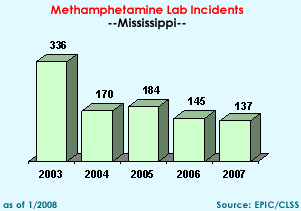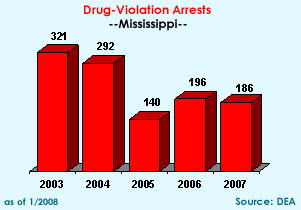|
DEA
Offices & Telephone Nos.
Gulfport—228-863-2992
Jackson—601-965-4400
Oxford—601-234-8542 |
State Facts
Population: 2,921,088
State Prison Population: 20,983
Probation Population: 21,324
Violent Crime Rate
National Ranking: 32 |
2008
Federal Drug Seizures
Cocaine: 232.4 kgs.
Heroin: 0.0 kgs.
Methamphetamine: 2.4 kgs.
Marijuana: 867.9 kgs.
Hashish: 0.0 kgs.
MDMA: 0.0 kgs./1,084 du
Methampehtamine
Laboratories: 296
(DEA, state,
and local) |
Drug
Situation: The movement of illegal drugs into and through Mississippi has been a significant problem for law enforcement for a number of years. Mississippi is ideally suited with its interstate system, deepwater and river ports, and air and rail systems as the “Crossroads of the South” to facilitate drug movement from the South Texas/Mexico area and Gulf ports to the entire Midwest and Eastern Seaboard of the United States. The state is comprised of 82 counties, located within 47,233 square miles, the majority offering rural agricultural areas. Mississippi has 362 miles of coastline extending from Louisiana to Alabama. Mississippi lies within 500 miles of more than 115 million consumers and 136 major metropolitan areas. Mississippi has an elaborate system of interstate highways and major thoroughfares that make traveling to these metropolitan areas quick and easy. Because of their large number, many of these highways are seldom patrolled. Mississippi has seven passenger airports including the Golden Triangle Regional Airport in Columbus, Tupelo Municipal Airport, Gulfport-Biloxi Airport in Gulfport, Hattiesburg-Laurel Regional Airport in Hattiesburg, Greenville Municipal Airport, Meridian Municipal Airport, and the Jackson-Evers International Airport in Jackson. In Mississippi alone, primary rail carriers on the nearly 3,000 miles of train track include the Illinois Central Railroad, Kansas City Southern, Burlington Northern, Columbus & Greenville Railroad Company, and Norfolk Southern System. Amtrak passenger service to and from New Orleans, Louisiana to Chicago, Illinois transits the entire State of Mississippi with major stops in state providing yet another conduit for transporting and distributing large quantities of all types of drugs.
 Cocaine:
Cocaine, primarily crack, is the primary drug threat in Mississippi due to the availability of the drug, its high addiction rate, and its propensity for violence. Cocaine:
Cocaine, primarily crack, is the primary drug threat in Mississippi due to the availability of the drug, its high addiction rate, and its propensity for violence.
- Cocaine, primarily crack, is the predominant drug threat in Mississippi.
- Cocaine is widely available and frequently distributed across the state.
- Cocaine abuse is reported in the metropolitan cities and rural and urban areas.
- The abuse and distribution of cocaine is associated with more incidents of violent crime than any other drug.
- Most of the powdered cocaine in the state is transported via private and commercial motor vehicles on Interstates 10 and 20 by Colombian and Mexican Drug Trafficking Organizations (DTOs) and African American criminal groups.
- African American street gangs and local independent dealers convert most of the powdered cocaine into crack cocaine for retail sales.
 Heroin:
Heroin is considered a minimal drug threat in Mississippi due to the low demand and high cost of the drug. Heroin:
Heroin is considered a minimal drug threat in Mississippi due to the low demand and high cost of the drug.
- Heroin is considered a low drug threat in most of Mississippi, although there have been some heroin seizures on the Coast. These seizures were primarily due to the coast’s proximity to New Orleans. Most heroin seizures resulted from interdiction stops destined for eastern states.
According to Herbert Loving, Director of the Mississippi Department of Mental Health (MDMH), Division of Alcohol, and Drugs, there are approximately 166,000 Mississippians in need of drug treatment. The state has 774 beds for residential and secondary therapeutic services and 83 inpatient beds. An additional 200 beds are located at Parchman penitentiary. According to the latest statistics, from January 1, 2005 through December 31, 2005 there were 20,938 admissions for drug and alcohol treatment. Of those receiving treatment, 12,652 were admitted for treatment for drug abuse. (See attached chart.) For fiscal year 2006, the State of Mississippi allocated $20.8 million for alcohol and drug treatment. Moreover, this funding is for treatment at state funded facilities only. Private programs are treating individuals as well without state subsidizing. The cost of treatment has increased 15 to 20 percent over the past five years. The projected increase in the cost of treatment is expected to continue at the same rate; however, this increase could change due to unforeseen events. The cost of treatment per person varies significantly, depending on the individual’s needs.
  Methamphetamine: Methamphetamine is the second most serious drug threat in Mississippi due to increasing availability, the rapid growth of abuse, the threat to human life, and the threat to the environment. Methamphetamine: Methamphetamine is the second most serious drug threat in Mississippi due to increasing availability, the rapid growth of abuse, the threat to human life, and the threat to the environment.
- Methamphetamine is the fastest growing drug threat in Mississippi.
- Law enforcement reporting indicates that methamphetamine is replacing crack cocaine as the primary drug threat due to the availability, low cost, and long lasting effect.
- Methamphetamine generates violent crime and hazardous conditions during production and distribution.
- Most of the methamphetamine available for resale in Mississippi is produced in and transported from Mexico via the Southwest Border states.
- Most of the methamphetamine produced in Mississippi is for local consumption and local markets.
- Caucasian independent groups are the primary producers of methamphetamine manufactured in Mississippi.
- African American independent groups are becoming involved in the use and distribution of methamphetamine.
 Club
Drugs: Other dangerous drugs (ODDs), including club drugs, hallucinogens and steroids, are not as significant a threat as other drugs. The availability and diversion of these drugs continue to increase in Mississippi. Club
Drugs: Other dangerous drugs (ODDs), including club drugs, hallucinogens and steroids, are not as significant a threat as other drugs. The availability and diversion of these drugs continue to increase in Mississippi.
- Other dangerous drugs are a continuous threat in Mississippi although not to the extent of cocaine, methamphetamine, and marijuana.
- The threat from club drugs such as MDMA has remained steady throughout the state.
- MDMA has become the most prevalent and popular of the “club drugs” in Mississippi.
- Club drugs are available usually in small quantities throughout the state, especially around university towns.
Diverted
Pharmaceuticals:
- The diversion of pharmaceutical drugs is a popular means for obtaining drugs illegally.
- Law enforcement officials report OxyContin abuse continues to be a viable threat.
- Everything from prescription forgeries to doctor-shopping aids in the diversion process; however, an increasing number of diverted pharmaceutical drugs are transported into Mississippi from Mexico and Southwest Border towns.
- Internet pharmacies are becoming more popular, despite inflated prices, due to the sites not requiring a prescription or a doctor’s examination.
- Methadone clinics in neighboring states continue to be a source for the abuse of Methadone by Mississippi residents.
 Marijuana: Marijuana is the most frequently abused and abundantly available drug in Mississippi. Marijuana: Marijuana is the most frequently abused and abundantly available drug in Mississippi.
- Marijuana continues to be the most commonly used drug in Mississippi. Reports indicate it is the gateway drug for teens and young adults who are beginning to experiment with drugs.
- Although treatment data indicates admission rates for marijuana abuse are moderate, abuse continues to be widespread.
- Locally grown marijuana is intended for local consumption.
- A higher-grade marijuana is becoming available due to the modern indoor cultivation techniques, influence of Vietnamese gangs and sources in Canada.
- Mexican marijuana is commonly transported into and through Mississippi along primary transportation routes.
- Criminal groups usually transport smaller shipments to reduce the effects of high volume seizures; however, recent reporting indicates the shipments are increasing in size.
- Local dealers, street gangs, and small ethnic trafficking groups distribute marijuana in the local market.
 DEA Mobile Enforcement Teams: This cooperative program with state and local law enforcement counterparts was conceived in 1995 in response to the overwhelming problem of drug-related violent crime in towns and cities across the nation. Since the inception of the MET Program, 473 deployments have been completed nationwide, resulting in 19,643 arrests. There have been seven MET deployments in the State of Mississippi since the inception of the program: Jackson (2), Gulfport, Hancock County, Greenville, Hattiesburg, and Grenada. DEA Mobile Enforcement Teams: This cooperative program with state and local law enforcement counterparts was conceived in 1995 in response to the overwhelming problem of drug-related violent crime in towns and cities across the nation. Since the inception of the MET Program, 473 deployments have been completed nationwide, resulting in 19,643 arrests. There have been seven MET deployments in the State of Mississippi since the inception of the program: Jackson (2), Gulfport, Hancock County, Greenville, Hattiesburg, and Grenada.
DEA
Regional Enforcement Teams:
This program was designed to augment existing DEA division resources
by targeting drug organizations operating in the United States where
there is a lack of sufficient local drug law enforcement. This program
was conceived in 1999 in response to the threat posed by drug trafficking
organizations that have established networks of cells to conduct drug
trafficking operations in smaller, non-traditional trafficking locations
in the United States. As of January 31, 2005, there have been 27 deployments
nationwide, and one deployment in the U.S. Virgin Islands, resulting
in 671 arrests. There have been no RET deployments in the state of Mississippi.
Special
Topics: HIDTA: The Gulf Coast HIDTA hosts the following DEA initiatives in Mississippi:
Major Investigations Team, Pearl, Mississippi
North Mississippi Methamphetamine Enforcement Team, Oxford, Mississippi
Tri-County Major Investigations Team, Gulfport, Mississippi
More information
about the New Orleans Division Office.
Sources
Factsheet last updated: 3/2008
Click here for last year's factsheet >>
|

